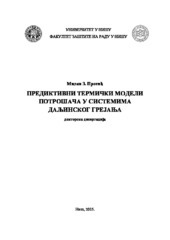Приказ основних података о дисертацији
Prediktivni termički modeli potrošača u sistemima daljinskog grejanja
| dc.contributor.advisor | Mitić, Dragan | |
| dc.contributor.other | Živković, Ljiljana | |
| dc.contributor.other | Nikolić, Vlastimir | |
| dc.contributor.other | Todorović, Branimir | |
| dc.contributor.other | Raos, Miomir | |
| dc.creator | Protić, Milan Z. | |
| dc.date.accessioned | 2016-08-27T16:00:47Z | |
| dc.date.available | 2016-08-27T16:00:47Z | |
| dc.date.available | 2020-07-03T16:15:52Z | |
| dc.date.issued | 2016-03-28 | |
| dc.identifier.uri | https://nardus.mpn.gov.rs/handle/123456789/6321 | |
| dc.identifier.uri | http://eteze.ni.ac.rs/application/showtheses?thesesId=3675 | |
| dc.identifier.uri | https://fedorani.ni.ac.rs/fedora/get/o:1117/bdef:Content/download | |
| dc.identifier.uri | http://vbs.rs/scripts/cobiss?command=DISPLAY&base=70052&RID=2048640608 | |
| dc.description.abstract | Today, district heating systems (DHS) in developed EU countries, especially in Scandinavia, are among the most efficient ways of providing citizens with heat in urban areas. Currently there are more than 6,000 DHS in Europe. In Serbia, there are DHS in 53 cities and towns, with the total installed capacity of 6,180 MW. Significant amounts of energy could be conserved by optimization of any segment in DHS operation. Despite the expansion of DHS in Europe, the operation of DHS in Serbia has been facing numerous issues in recent years. The issues pertain to inefficient and uneconomical DHS operations, which are compensated by raised prices of distributed heat, consequently causing consumer dissatisfaction. The issues became evident when DHS stopped being subsidised by the local governments, and especially after gas market liberalization. Uneconomical operation of DHS is mostly the result of the way thermal energy is produced and of inefficient management. It is possible to change the method of thermal energy production in DHS by replacing the existing heat sources with less costly ones, such as cogeneration facilities running on fossil fuels or biomass, or by introducing incineration, solar, and geothermal plants. However, any change of heat sources in the current DHS constellation is a long-lasting process that requires considerable investment. On the other hand, by improving the existing inefficient management method, it is possible to significantly enhance DHS operations with relatively small investment and it is this aspect of DHS operation improvement that is the focus of this dissertation. The conducted research was based on three initial assumptions: (1) DHS in cold and moderate climate regions are among the most efficient and most economical ways of providing heat to citizens in urban areas; (2) The installed capacity and the currently energy-inefficient and uneconomical DHS operation in Serbia justify research aimed at optimizing these systems; and (3) Development of robust and credible predictive thermal models of consumers and their integration into management strategies of DHS can immensely contribute to more efficient and more economical production and distribution of thermal energy. The abovementioned assumptions converge into the aim of this research: development and verification of predictive thermal models of consumers in district heating systems, which will enable more energy-efficient and economical management of thermal energy production and distribution. The research includes a theoretical and a practical segment. The methods used are analysis, synthesis, experiment, and result verification. Theoretical research involves a review and referencing of foreign and domestic current and competent literature, while the synthesis of the listed information is used to determine the most suitable approach to resolving the identified issues. The first part of the practical segment involves the setup of an experimental installation in the substation of the Niš DHS in order to sample relevant data, which are then used for the development of predictive thermal models. The second part involves the application of three methods of statistical learning (neural networks with direct signal propagation and Bayesian regularization, support vector machines, and a boosting method) for the creation of predictive models. The obtained results were verified by means of the data that were not used for predictive modelling. Additionally, the potential of the developed models was also verified against the data obtained from the Novi Sad DHS. The following are the key contributions of this dissertation: (1) It analyzes the benefits of DHS as a sustainable and energy-efficient method of providing heat to people living in urban areas, with a special focus on the possible use of renewable energy sources; (2) It systematizes previous research regarding predictive thermal modelling of consumers in DHS; (3) It involves a setup of an experimental installation, which conducted continuous measurement and sampling of relevant quantities from a Niš DHS substation; (4) It involves development and testing of several types of predictive models of heating load for different prediction horizons based on statistical learning methods: neural networks with direct signal propagation and Bayesian regularization, support vector machines, and a boosting method using the experimentally obtained data; (5) It analyzes the possibility of applying the selected methods to predictive modelling in the differently operationally organized DHS in Novi Sad, as well; (6) It develops short-term predictive models of outdoor temperature; and (7) It establishes that the developed predictive models of heating load can be considerably improved by introduction of predictive models of climatic parameters, in particular of the outdoor temperature. The obtained results indicate that the application of statistical learning methods, especially the support vector machines, allows the development of predictive thermal models of consumers with satisfactory performance. This creates the necessary conditions for their integration into an advanced managerial environment and thus for optimal and more economical operation of DHS. | en |
| dc.format | application/pdf | |
| dc.language | sr | |
| dc.publisher | Универзитет у Нишу, Факултет заштите на раду | sr |
| dc.rights | openAccess | en |
| dc.rights.uri | https://creativecommons.org/licenses/by-nc-nd/4.0/ | |
| dc.source | Универзитет у Нишу | sr |
| dc.subject | sistemi daljinskog grejanja | sr |
| dc.subject | district heating systems | en |
| dc.subject | improvement of management | en |
| dc.subject | predictive thermal models | en |
| dc.subject | neural networks | en |
| dc.subject | support vector machines | en |
| dc.subject | boosting method | en |
| dc.subject | unapređenje upravljanja | sr |
| dc.subject | prediktivni termički modeli | sr |
| dc.subject | neuronske mreže | sr |
| dc.subject | metod potpornih vektora | sr |
| dc.subject | boosting metod | sr |
| dc.title | Prediktivni termički modeli potrošača u sistemima daljinskog grejanja | sr |
| dc.type | doctoralThesis | en |
| dc.rights.license | BY-NC-ND | |
| dcterms.abstract | Митић, Драган; Тодоровић, Бранимир; Раос, Миомир; Живковић, Љиљана; Николић, Властимир; Протић, Милан З.; Предиктивни термички модели потрошача у системима даљинског грејања; Предиктивни термички модели потрошача у системима даљинског грејања; | |
| dc.identifier.fulltext | https://nardus.mpn.gov.rs/bitstream/id/55011/Disertacija4367.pdf | |
| dc.identifier.fulltext | http://nardus.mpn.gov.rs/bitstream/id/55011/Disertacija4367.pdf | |
| dc.identifier.fulltext | http://nardus.mpn.gov.rs/bitstream/id/55012/Protic_Milan_Z.pdf | |
| dc.identifier.fulltext | https://nardus.mpn.gov.rs/bitstream/id/55012/Protic_Milan_Z.pdf | |
| dc.identifier.rcub | https://hdl.handle.net/21.15107/rcub_nardus_6321 |



